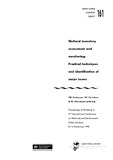Assessment and monitoring of wetlands for conservation and development in dry lands: A case study of Kajiado District, Kenya
Date
1998Author
Gichuki, NN
Oyieke, HA
Ndiritu, GG
Type
PresentationLanguage
enMetadata
Show full item recordAbstract
African wetlands constitute an important natural resource base and are actively utilised by
rural communities for socio-economic activities. However, vital information on their
functions, values, uses and threats is lacking in many parts of the continent. This makes it
difficult to plan for wetland conservation and to integrate conservation and development goals
at a local level. This paper presents the results of a two-year study of wetlands in Kajiado
district (36°30 E, 2°10 S), a semi-arid area in southern Kenya. The physical inventory of
wetlands was carried out using topographic maps (scale 1:50 000) and aerial photographs of
the district together with field surveys undertaken during the period March 1996 April 1998.
Biological inventory was carried out by sampling higher plants and animals on each major
wetland.
Data on wetland values, uses, threats and conservation initiatives was gathered through direct
and indirect methods. 80% of Kajiado district (21 105 km2) is semi-arid. Wetlands cover
about 2% of the total area, most of them occurring in the high water potential areas of Ngong
Hills, Mau-Nguruman escarpments and Mt. Kilimanjaro. Fifteen wetlands ranging in size
from 10 to 15 000 ha were found and comprised lakes, rivers, swamps, marshes, floodplains,
natural springs, man-made dams, ponds and pans. Water quality and quantity varied
considerably between wetlands and between seasons. Species diversity was relatively low in
marshes and swamps but even lower in saline lakes and seasonal rivers. Permanent fresh
water wetlands provided water for domestic and livestock consumption and for irrigation.
Subsistence fisheries and livestock grazing took place in some permanent freshwater
wetlands. Aquaculture for fish production and control of water-based disease vectors was a
rapidly growing community activity. The primary threats to wetlands were due to pollution,
siltation and colonisation by exotic species. The results of this study indicate that wetlands
play a vital role in conserving biological diversity, supporting human life and economic
activities in the dry lands of Africa.
URI
http://155.187.2.69/ssd/publications/ssr/pubs/ssr161.pdf#page=103http://hdl.handle.net/11295/39447
Citation
Proceedings of Workshop 4 2 nd International Conference on Wetlands and Development, Dakar, Senegal, 8ñ14 November 1998Publisher
College of Biological Sciences, University of Nairobi Centre for Biodiversity, National Museums of Kenya,

